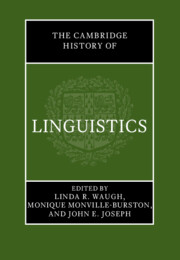Book contents
- The Cambridge History of Linguistics
- The Cambridge History of Linguistics
- Copyright page
- Dedication
- Contents
- Figures
- Tables
- Contributors
- Preface
- Acknowledgments
- Abbreviations, Acronyms, Special Symbols, and Other Conventions
- Introduction
- Part I Ancient, Classical, and Medieval Periods
- Introduction To Part I The Emergence of Linguistic Thinking within Premodern Cultural Practices
- 1 Ancient Near Eastern Linguistic Traditions: Mesopotamia, Egypt
- 2 East Asian Early Linguistic Traditions: China; Korea and Japan
- 3 History of Linguistic Analysis in the Sanskrit Tradition in Premodern India, with a Brief Discussion of Vernacular Grammars
- 4 Greek Linguistic Thought and its Roman Reception
- 5 Early to Late Medieval Europe
- 6 Near Eastern Linguistic Traditions
- 6A The Syriac Linguistic Tradition
- 6B The Hebrew Linguistic Tradition
- 6C The Arabic Linguistic Tradition
- Part II Renaissance to Late Nineteenth Century
- Part III Late Nineteenth-through Twentieth-Century Linguistics
- Part IIIA Late Nineteenth Century through the 1950s: Synchrony, Autonomy, and Structuralism
- Part IIIB 1960–2000: Formalism, Cognitivism, Language Use and Function, Interdisciplinarity
- References
- Index
5 - Early to Late Medieval Europe
from Part I - Ancient, Classical, and Medieval Periods
Published online by Cambridge University Press: 20 July 2023
- The Cambridge History of Linguistics
- The Cambridge History of Linguistics
- Copyright page
- Dedication
- Contents
- Figures
- Tables
- Contributors
- Preface
- Acknowledgments
- Abbreviations, Acronyms, Special Symbols, and Other Conventions
- Introduction
- Part I Ancient, Classical, and Medieval Periods
- Introduction To Part I The Emergence of Linguistic Thinking within Premodern Cultural Practices
- 1 Ancient Near Eastern Linguistic Traditions: Mesopotamia, Egypt
- 2 East Asian Early Linguistic Traditions: China; Korea and Japan
- 3 History of Linguistic Analysis in the Sanskrit Tradition in Premodern India, with a Brief Discussion of Vernacular Grammars
- 4 Greek Linguistic Thought and its Roman Reception
- 5 Early to Late Medieval Europe
- 6 Near Eastern Linguistic Traditions
- 6A The Syriac Linguistic Tradition
- 6B The Hebrew Linguistic Tradition
- 6C The Arabic Linguistic Tradition
- Part II Renaissance to Late Nineteenth Century
- Part III Late Nineteenth-through Twentieth-Century Linguistics
- Part IIIA Late Nineteenth Century through the 1950s: Synchrony, Autonomy, and Structuralism
- Part IIIB 1960–2000: Formalism, Cognitivism, Language Use and Function, Interdisciplinarity
- References
- Index
Summary
By the fifth century Latin had become the language of education and been brought to new areas via the expansion of Christianity. The grammars by Donatus (fourth century) and Priscian’s (sixth century) were the canonical textbooks.The Carolingian Renaissance (eighth-ninth century) had linguistic consequences: promotion of scholarship, return to original texts, reform of pronunciation. The twelfth century represents a turning point in the study of language: the aim is not just describing Latin and practical training, but reflecting on the relationship between ‘dialectic’ (logic) and grammar (cf. Peter Helias). This opened the way to a general/formal theory of language, ‘speculative grammar.’ It flourished in the thirteenth century, with the idea that language intervenes both in the knowledge of reality and the theory of the ‘modes of signifying.' The Modistae systematized their predecessors’ work and investigated further the relation of grammar and meaning and the universal properties of language. In the fifteenth century the nominalists, for whom the modes of signifying were unnecessary, attacked their theories.The author notes an interest in pragmatics coming from theologians, rather than grammarians and philosophers. The chapter closes on a review of grammars of vernaculars (Catalan, Provençal, Old French).
Keywords
- Type
- Chapter
- Information
- The Cambridge History of Linguistics , pp. 144 - 174Publisher: Cambridge University PressPrint publication year: 2023



